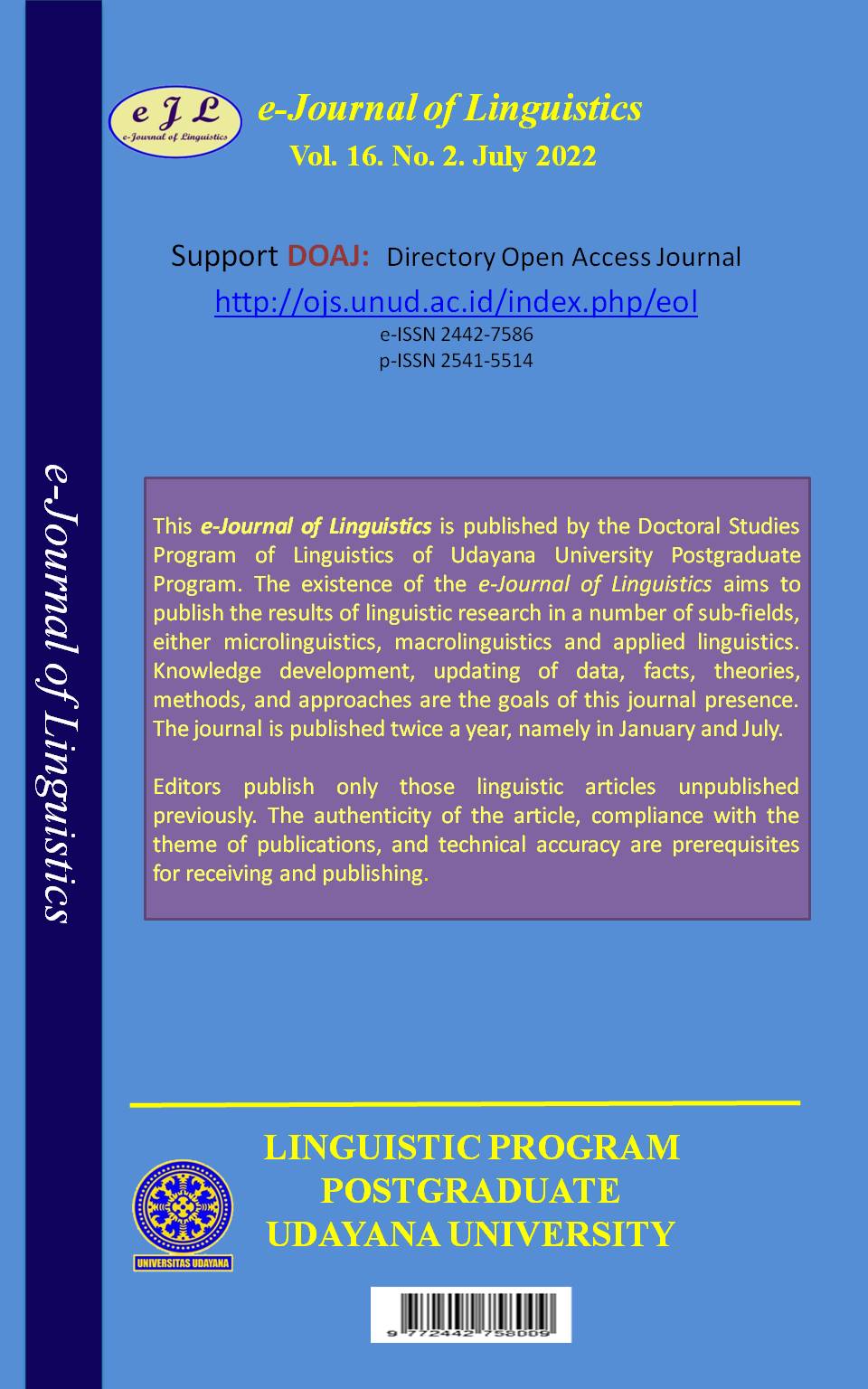Expressive Acts in Euphoria Special Episode Part 1: Trouble Don’t Last Always
Abstract
The research identifies the type of expressive acts uttered by the characters in a special episode entitled Euphoria Part 1: Rue – Trouble Don’t Last Always and the research implements Norrick theory to analyze the data. Then, the research designs the activity in qualitative method which shapes how the report of the analysis would be descriptively. In collecting the data, the research appropriates Observational method and non-participation technique by Sudaryanto. On the other hand, in analyzing the data, the research appropriates Pragmatic Identity Method and Matching technique by Sudaryanto. The research found 26 utterances identified completely of the types of expressive acts; (2) apologizing, (1) thanking, (1) congratulating, (4) condoling, (5) deploring, (8) lamenting, (2) welcoming, (2) forgiving, and (1) boasting. Lamenting is the most frequent expressive act as the central story of the episode where the main character shared their sorrow and regret to their friend.
Downloads
References
Birner, B. J. (2013). Introduction to Pragmatics. Blackwell Publishing.
Creswell, J. W., & Creswell, J. D. (2018). Research design qualitative, quantitative, and mixed methods approaches (5th ed.). SAGE Publications, Inc.
Fauzia, & Tressyalina. (2019). Expressive speech actions in the novel Ayahku Bukan Pembohong and Dia adalah Kakakku by Tere Liye. Proceedings of the 2nd International Conference on Language, Literature and Education, ICLLE 2019, 22-23 August, Padang, West Sumatra, Indonesia. https://doi.org/10.4108/eai.19-7-2019.2289495
Levinson, S. (2020). Euphoria Special Episode Part 1: Rue - Trouble Don’t Last Always. HBO Studio;A24 Television; Dreamcrew; Little Lamb; Tedy Productions; The Reasonable Bunch.
Mey, J. L. (1993). Pragmatics: An introduction (1st Ed.). Blackwell Publishing.
Nasution, M. A. S., Lubis, S., & Mono, U. (2019). Illocutionary act in ABC new interview with Meghan Markle and Prince Harry: A pragmatic study. Journal of Language, Literature, and Teaching, 1(2), 7–21. https://doi.org/10.35529/jllte.v1i2.7-21
Norrick, N. R. (1978). Expressive illocutionary acts. Journal of Pragmatics, 2(3), 277–291. https://doi.org/10.1016/0378-2166(78)90005-x
Nuraini, F. I., Santoso, D., Rahmi, N. S., & Kaptania, R. O. (2020). Expressive speech acts in Lakon Politik Republik episode of Mata Najwa talkshow. Leksema: Jurnal Bahasa Dan Sastra, 5(1), 1–13. https://doi.org/10.22515/ljbs.v5i1.1853
Royanti, R. (2019). Expressive speech act as found on La La Land movie. Inovish Journal, 4(2), 131–140. https://doi.org/10.35314/inovish.v4i2.1162
Searle, J. R. (1976). A classification of illocutionary acts. Language in Society, 5(1), 1–23. https://doi.org/10.1017/S0047404500006837
Searle, J. R. (2005). Expression and meaning: Studies in the theory of speech acts. Cambridge University Press.
Sembiring, W. A., & Ambalegin, A. (2019). Illocutionary acts on Aladdin movie 2019. Journal Basis, 6(2), 277–284. https://doi.org/10.33884/basisupb.v6i2.1419
Setiani, A., & Utami, D. P. (2018). An analysis of illocutionary act in “How to Train Your Dragon 2” movie. PROJECT: Professional Journal of English Education, 1(3), 225–234. https://doi.org/10.22460/project.v1i3.p225-234
Sudaryanto. (1993). Metode dan aneka teknik bahasa. Duta Wacana University Press.
Tamam, B., Setiawan, S., & Anam, S. (2020). The expressive speech act used by Anies Rasyid Baswedan and Recep Tayyip Erdogan as the reaction of the attacks in Christchurch New Zealand. Prasasti: Journal of Linguistics, 5(1), 16–29. https://doi.org/10.20961/prasasti.v5i1.39424
Wijayanti, A. A. R. P., & Widiastuti, N. M. A. (2021). Direct and indirect expressive illocutionary acts in the movie Onward. E-Journal of Linguistics, 15(2), 279–286. https://doi.org/10.24843/e-jl.2021.v15.i02.p14
Yule, G. (1996). Pragmatics (2nd ed.). Oxford University Press.

This work is licensed under a Creative Commons Attribution 4.0 International License











